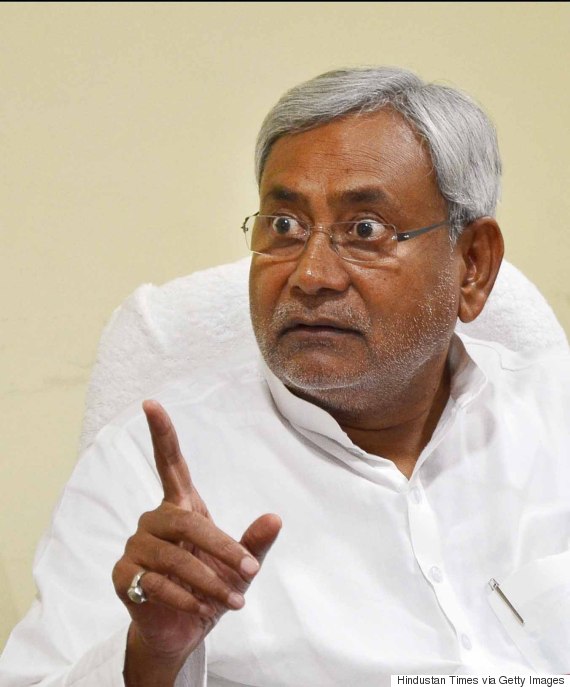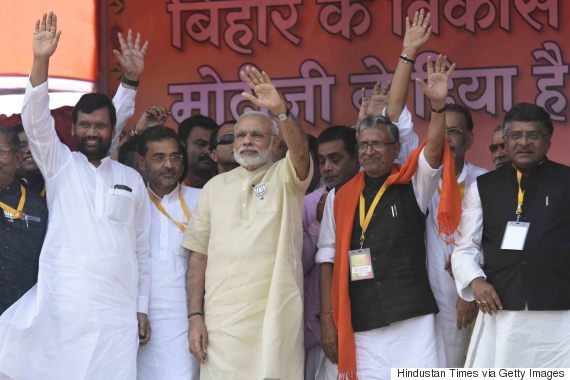In June this year, Lalu Yadav ‘drank poison’ to accept the leadership of Nitish Kumar for the Bihar elections. However, Nitish Kumar’s party was internally debating this partnership until as late as July-end. Was Lalu a greater liability than he was an asset? Can Nitish win the election all by himself? The debate was settled by Narendra Modi’s first rally, in Muzaffarpur on 25 July.
In the run up to the rally, the BJP had put up hoardings all over Patna attacking the Nitish-Lalu-Congress alliance as an alliance of arrogance, crime and corruption. It was noteworthy that BJP wasn’t able to accuse Nitish of much except arrogance, the anti-corruption sentiment against the Congress had fizzled out, but Lalu was a problem.
Nitish Kumar was busy projecting himself as the face of the election, and there was no visible public sign of any alliance. This had tongues wagging about whether the alliance can work out or not. Inside the JD(U), it was a moot question.
At the campaign level, allying with a tainted Lalu had given the BJP some very powerful ammunition on a platter. It was a hypocritical alliance: Nitish was everything opposite of Lalu, and now he was joining forces with Lalu.
What if Nitish goes it alone?
This could have been a problem at the ground level too. Lalu Yadav’s twin votebanks of Muslim and Yadav are both polarising communities. The Yadavs could have alienated the Extremely Backward Classes, who remember the Jungle Raj days of the Lalu era. And the Muslim votebank decisively on one side could have been used by the BJP to use its tried and tested strategy of Hindu-Muslim polarisation. Then there was the upper caste vote, some of which Nitish could have got if only he wasn’t allying with Lalu.
![modi nitish]()
However, not allying with Lalu would also have been a risk. We saw how Nitish fared alone in the 2014 Lok Sabha elections. On his own, Nitish has only a small number of Kurmi votes. His pro-incumbency image would have got have some more votes from EBCs, upper castes and Muslims, but it would have been a gamble.
Nitish Kumar’s campaign manager, Prashant Kishor, who had switched over from Narendra Modi’s team, was in favour of breaking the alliance. Nitish Kumar has never won an election without an alliance, but Kishor felt that with his pro-incumbency, Nitish could do a Naveen Patnaik.
Much of the party felt they can’t do without Lalu. In a three-way contest, the BJP would have a better chance in projecting themselves as winnable. But how does one handle Lalu’s “Jungle Raj” image?
Waiting for Modi
Modi’s first rally on 25 July in Muzaffarpur was bound to set the agenda.
The JD(U) campaign expected Modi to lash out at the Nitish-Lalu alliance, reminding people of Jungle Raj, promising development. The Nitish campaign wanted to see the Muzaffarpur rally, and then take a call. If Lalu was becoming a campaign liability, they were willing to take the issue away from the BJP. By 15 August, the Lalu alliance could have been called off.
The arrival of Narendra Modi is a phenomenon of epic proportions. Modi the great orator, Modi the seller of dreams, Modi the game-changer, Modi the most powerful prime minister since Indira Gandhi. Modi sets the scene, and it becomes all Modi, Modi, Modi.
Nitish Kumar prepared well for this. To make sure their cadres were not demoralised by Modi’s arrival, they did heavy outdoor and door-to-door campaigning in Muzaffarpur for ten days leading up to Modi’s rally. To counter Modi's promises, hoardings suddenly came up on the morning 25 July, saying "jhanse mein na aayenge, Nitish ko jitayenge" (we won't be deceived, we'll make Nitish win). The hoardings, like the morning tweets, were part of Prashant Kishor's plan to take the BJP by surprise, and not give them enough time to think.
Modi was to arrive in Patna, address three government functions, and the go to Muzaffarpur. Just before Modi landed, Nitish Kumar sent out a volley of tweets with taunts and questions for the prime minister. Welcoming Modi in patna, Nitish in his speech attacked the central government heavily, reminding every central minister present of their promises for Bihar.
The DNA din
Modi began his speech in Muzaffarpur by referring to Nitish Kumar’s tweets. This was the first sign that Nitish’s strategy was working. Modi had already been put on the back foot, forced to respond to Nitish.
![modi nitish]()
Then Modi went on to make a blunder. He began the rally with a sharp personal attack on Nitish. It’s as if this election was about settling personal scores. I was told not to enter Bihar, I was insulted, he broke the alliance for personal ego, he discarded a Mahadalit like Jitan Ram Manjhi. It seems, Modi said, his DNA is of poor quality.
Modi went on to attack the alliance and talk of “Jungle Raj”, but the JD(U) camp had got what it wanted. As soon as Modi left for Delhi, Nitish Kumar did a press conference, attacking Modi for the DNA remark. The Nitish campaign made the Bihari DNA an issue, making sure that everything else Modi said was lost in the DNA din. The press conference was deliberately held the moment Modi boarded the flight for Delhi, so that he is unable to consult his advisors and chalk out an immediate response.
There may be little resonance of the DNA issue amongst voters, but it served its purpose at the campaign level. As DNA made the headlines for days to come, it helped take attention away from Jungle Raj. The Nitish-Lalu alliance was sealed.
![]() Like Us On Facebook |
Like Us On Facebook |
![]() Follow Us On Twitter |
Follow Us On Twitter |
![]() Contact HuffPost India
Contact HuffPost India
In the run up to the rally, the BJP had put up hoardings all over Patna attacking the Nitish-Lalu-Congress alliance as an alliance of arrogance, crime and corruption. It was noteworthy that BJP wasn’t able to accuse Nitish of much except arrogance, the anti-corruption sentiment against the Congress had fizzled out, but Lalu was a problem.
Nitish Kumar was busy projecting himself as the face of the election, and there was no visible public sign of any alliance. This had tongues wagging about whether the alliance can work out or not. Inside the JD(U), it was a moot question.
At the campaign level, allying with a tainted Lalu had given the BJP some very powerful ammunition on a platter. It was a hypocritical alliance: Nitish was everything opposite of Lalu, and now he was joining forces with Lalu.
What if Nitish goes it alone?
This could have been a problem at the ground level too. Lalu Yadav’s twin votebanks of Muslim and Yadav are both polarising communities. The Yadavs could have alienated the Extremely Backward Classes, who remember the Jungle Raj days of the Lalu era. And the Muslim votebank decisively on one side could have been used by the BJP to use its tried and tested strategy of Hindu-Muslim polarisation. Then there was the upper caste vote, some of which Nitish could have got if only he wasn’t allying with Lalu.

However, not allying with Lalu would also have been a risk. We saw how Nitish fared alone in the 2014 Lok Sabha elections. On his own, Nitish has only a small number of Kurmi votes. His pro-incumbency image would have got have some more votes from EBCs, upper castes and Muslims, but it would have been a gamble.
Nitish Kumar’s campaign manager, Prashant Kishor, who had switched over from Narendra Modi’s team, was in favour of breaking the alliance. Nitish Kumar has never won an election without an alliance, but Kishor felt that with his pro-incumbency, Nitish could do a Naveen Patnaik.
Much of the party felt they can’t do without Lalu. In a three-way contest, the BJP would have a better chance in projecting themselves as winnable. But how does one handle Lalu’s “Jungle Raj” image?
Waiting for Modi
Modi’s first rally on 25 July in Muzaffarpur was bound to set the agenda.
The JD(U) campaign expected Modi to lash out at the Nitish-Lalu alliance, reminding people of Jungle Raj, promising development. The Nitish campaign wanted to see the Muzaffarpur rally, and then take a call. If Lalu was becoming a campaign liability, they were willing to take the issue away from the BJP. By 15 August, the Lalu alliance could have been called off.
The arrival of Narendra Modi is a phenomenon of epic proportions. Modi the great orator, Modi the seller of dreams, Modi the game-changer, Modi the most powerful prime minister since Indira Gandhi. Modi sets the scene, and it becomes all Modi, Modi, Modi.
Also read: Red And Yellow Are Nitish-Lalu's Colours This Election
10 Reasons Why The Grand Alliance Is Doing Better Than The NDA In Bihar
Nitish Kumar prepared well for this. To make sure their cadres were not demoralised by Modi’s arrival, they did heavy outdoor and door-to-door campaigning in Muzaffarpur for ten days leading up to Modi’s rally. To counter Modi's promises, hoardings suddenly came up on the morning 25 July, saying "jhanse mein na aayenge, Nitish ko jitayenge" (we won't be deceived, we'll make Nitish win). The hoardings, like the morning tweets, were part of Prashant Kishor's plan to take the BJP by surprise, and not give them enough time to think.
Modi was to arrive in Patna, address three government functions, and the go to Muzaffarpur. Just before Modi landed, Nitish Kumar sent out a volley of tweets with taunts and questions for the prime minister. Welcoming Modi in patna, Nitish in his speech attacked the central government heavily, reminding every central minister present of their promises for Bihar.
The DNA din
Modi began his speech in Muzaffarpur by referring to Nitish Kumar’s tweets. This was the first sign that Nitish’s strategy was working. Modi had already been put on the back foot, forced to respond to Nitish.

Then Modi went on to make a blunder. He began the rally with a sharp personal attack on Nitish. It’s as if this election was about settling personal scores. I was told not to enter Bihar, I was insulted, he broke the alliance for personal ego, he discarded a Mahadalit like Jitan Ram Manjhi. It seems, Modi said, his DNA is of poor quality.
Modi went on to attack the alliance and talk of “Jungle Raj”, but the JD(U) camp had got what it wanted. As soon as Modi left for Delhi, Nitish Kumar did a press conference, attacking Modi for the DNA remark. The Nitish campaign made the Bihari DNA an issue, making sure that everything else Modi said was lost in the DNA din. The press conference was deliberately held the moment Modi boarded the flight for Delhi, so that he is unable to consult his advisors and chalk out an immediate response.
There may be little resonance of the DNA issue amongst voters, but it served its purpose at the campaign level. As DNA made the headlines for days to come, it helped take attention away from Jungle Raj. The Nitish-Lalu alliance was sealed.
 Like Us On Facebook |
Like Us On Facebook |  Follow Us On Twitter |
Follow Us On Twitter |